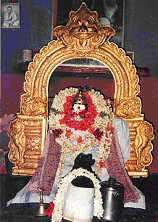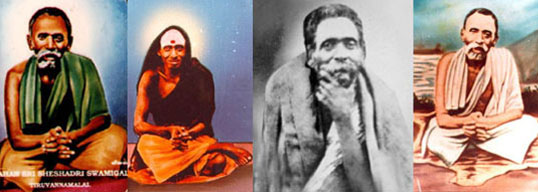
Mahaan’s
samadhi at Séshadri Swamigal Ashram |
Mahaan's
birth
The appearance of Divine Light, on Saturday, 22nd January 1870, (11th
day of Tamil month, Thai) signaled the birth of Mahaan when the Hastha
star was in the ascendant. Sri Séshadri Swamigal was born to
Vardarajan and Margathammal. As he was born on a Saturday, He
was given the name Séshadri in honor of Lord Srinivasa (Balaji).
When he was four years of age he would sing devotional songs and stotras,
taught by his mother, in a melodious voice and everyone regarded the
boy as a Divine-child.
How he came to be know as Séshadri with the Golden
Hand
Every day, Mahaan's mother used to take the child Séshadri
to the temple. On their way one shopkeeper would sell Krishna idols.
One day the child got down on seeing the beautiful idols of Lord Krishna,
and told his mother that he would perform puja (prayers) to Lord Krishna.
The shopkeeper was so happy to see the child's interest that he gave
the idol free to the child.
The next day when Magathammal went with the child to the temple, the
shop- keeper prostrated at her feet and took the child's hand and
saluted it saying "Golden Hand", "Golden Hand".
All the bystanders were surprised at the attitude of the shop-keeper.
He started explaining that he never had such tremendous sales and
attributed it to the touch of the divine child. He went on to say
that all the idols were sold out. This news spread throughout the
village and everyone started addressing Séshadri as "Thanga
Kai Séshadri", which means "Séshadri
with the Golden Hand."
Through out His life Sri Séshadri performed many miracles and
continues to do so to this day (through his subtle body and also through
his disciples.)
His youth
When he was 5 years of age, he was sent to school in the traditional
and orthodox manner. At the age of 7, Upanayanam (sacred
thread ceremony) was performed. When he was 14, his father died. By
16 years of age, he completed his education. He had mastered various
texts in Sanskrit and Tamil -- the whole Vedanta with three
primary texts - Gita, Upanishads and Brahma Sutras,
besides Vedas, Nyaya and Vyakarana. He had also
mastered music and astrology. When he was 17, his people tried to
marry him off, but astrologers predicting his horoscope that he will
become a Sanyasin (Recluse) and Jivan-mukta (realised
soul), dropped the idea.
When his mother was to breath her last, she chanted two slokas keeping
her hand on the chest of Séshadri -- one of Sri Adi
Sankara -- (Sat Sangatve - in Baja Govindam)
which meant that the company of the good led one in time to solitude
and thence to emancipation and the other sloka indicated the sacredness
of Arunachala -- how merely by thinking of it, one
attained ultimate Bliss. Repeating the word "Arunachala"
in her tongue, she breathed her last on the lap of Séshadri.
He took these two slokas from her mother for guidance in his life.
Arunachala stands for Lord Shiva
in Agni (fire) form at Thiruvannamalai. He drew a
picture of Arunachala by instinct. His personal Gods
were Goddess Kamakshi of Kanchipuram and Sri
Rama - the divine avatar (God in the form of a person) depicted
in Ramayanam (a great literary work of Bharath
written by Valmiki Maharishi and adopted by several
others in other languages).
Austerities as a young man
With the pictures of Arunachala, Rama and Kamakshi his worship was
going strong. He had no sleep and no appetite. He was seen in Chakrath-Azhwar
and Kamakshi temples for several hours chanting mantras, slokas,
etc. His rigorous and exacting religious practices were viewed with
concern by his foster-parents who were taking care of him. He got
immersed in Sri Kamakshi's divine form and regarded
himself as Goddess Parvathi (Sakthi aspect
of Brahmam). He began doing his meditations in Rudrabhoomi
(cremation ground) which was resented and questioned by his people.
He was wandering in the streets of Kanchipuram, when he met a Gouda
Sanyasi, Sri Balaji Paramahamsa, who finding him worthy and
fit, gave him sanyasa (the fourth stage of asrama in one's
life). On the due date, Séshadri's father's annual ceremony
was performed. To give him his father's blessings, he was brought
home forcibly and kept locked in a room. At a stage, when the room
was opened his relatives noticed that Séshadri had disappeared
from the locked room and then only realised his greatness and attainment.
He was 19 years of age then. After sometime he was noticed in the
temple precincts of Sri Mukteswara at Kaveripakkam,
20 miles away from Kanchipuram.
One day, in the temple, a big serpent came out; Séshadri beckoned
it and it came and coiled over his body and held its hood over his
head. Those who witnessed were awe-struck. Séshadri now "Séshadri
Swami" was unperturbed. His act showed that all creations
of Almighty are alike and is all pervasive.
SPIRITUAL LIFE IN THIRUVANNAMALAI
At the age of 19, in the year 1889 AD, he reached Thiruvannamalai
and never left its outskirts, till HE dropped his mortal-coil on 4.1.1929
AD.
His 40 years of spiritual life in Thiruvannamalai showed that Swamigal
was God himself. Speaking and walking among People, he was Sanchara-Dakshinamurthi
(God as man on the move). His biography vividly shows that he was
a Jivan-mukta (a realised soul while in body). He did not
have body-consciousness and was in ever communion with his Atman (Soul).
He saw atman in everything-animate and inanimate. He was seen going
round and round a stone pillar and doing pranams (offering his worship)
and saying that he was seeing God in it. Similarly he used to worship
animals-buffalo, donkeys--seeing God in them. Sometimes he would embrace
people on the road including ladies and say that he saw para-sakthi
(mother aspect of Brahmam) in them. He did not have any fixed abode.
He was always on the move. He will be seen at many places within a
few minutes. He will be in rags and dirty clothes. He will enter any
shop on the roads and pull out anything from them. The shopkeepers
revered him and considered his visit and touch as a great blessing.
If anyone gives him a new cloth, he will wear it for a while and give
it to someone. Sometimes he will be seen going half-shaven. He appeared
without a bath and his hairs matted and hung pell-mell round his neck.
There was always a heavenly-smile in his face. Eyes always remained
half-closed and turned inward in eternal contemplation. When opened
they looked beautiful and slightly orange-tinged like a full moon.
If at all he sat, he was in Swastik Asana, with his ankles
crossed and the rest of his body poised over and out of contact with
the ground. There was a devotee by name Manikkam. He would beg in
the streets and collect some food and offer it to Swamigal. If Swamigal
does not eat, he too would not eat. The stale food would remain for
days and Swamigal may some times take it not minding its foul smell.
So was his detachment from the body and things of the world. All were
alike to him; None is a known one or unknown one. He was a saint of
advanced spirituality. He possessed supernal powers and Godly possession.
There was total abdication. Sthitha-pragna state spoken in
chapter II of Bhagavad-Gita and Mano-nasam (control of mind)
mentioned in various scriptures including Bruhadarinya Upanishad
are the "states" the Swamigal attained. He did not get entangled
in siddies (Spiritual powers) attained by him. Sri Swamigal
was one of the greatest saints of our land and whose holiness has
few parallels.
One Vitoba Swamigal was at Polur, 10 miles away from
Thiruvannamalai. When he passed away, Sri Séshadri Swamigal
was running in the streets of Thiruvannamalai shouting that Vitoba
was ascending to Heaven. His power of clairvoyance was astonishing.
The news from Polur reached Thiruvannamalai much later.
When Sri Ramana Maharishi was in his younger days
doing meditation in Pathala Linga cave of Arunachala Temple,
it was Sri Séshadri Swamigal who gave him
protection from urchins and brought him to the notice of the world.
Ramana, younger in age used to be called Chinna-Séshadri
(Little Séshadri). Sri Séshadri was called Mother
Parvathi and Sri Ramana as Skanda (Lord
Subramanya). There were instances when devotees have experienced
that Séshadri was Ramana and Ramana was Séshadri. They
were contemporaries and each knew the greatness of the other. Sri
Ramana's presence, when Sri Séshadri's body was interred and
Sri Ramana's personal reading and approval of script of Séshadri's
Biography showed Ramana's reverence for this great Mahaan. Many were
his beneficiaries. Sri Vallimalai Swamigal, Kavyakanta
Ganapathi Muni and Bhanu Kavi are to cite
a few. Even men of ordinary walk of life had their several ills-mental
and physical cured. Several had initiation in mantras according to
their eligibility.
His Holy-body was interred in a Samadhi, witnessed by Sri
Ramana Maharishi and several devotees, at Thiruvannamalai
- Tamil Nadu (South India). There is a beautiful temple and ashram
there and He is worshipped daily. Tiruvannamalai is about two hundred
kilometres from Bangalore, and about the same distance from Chennai.
Séshadri Swamigal ashram is next to Sri Ramanashramam between
the second and third Lingam
on the circumabulation route. Regular pujas are performed at the samadhi
of Sri Séshadri Swamigal. There are a few platforms for meditation
in the open, in a beautiful garden, under the cool shade of trees.
One can do meditation facing the holy hill Arunachala,
from this garden. A book stall in the ashram sells photographs and
books. Accommodation (with or without air-conditioning) is available
and there is a restaurant inside the ashram.
|
|

